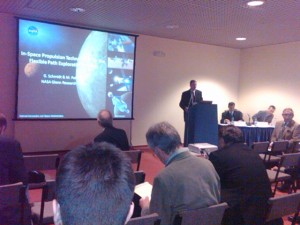by Kelvin Long
No one gets more done on a Blackberry than Kelvin Long, one of the powerhouses behind Project Icarus. Kelvin has been in Prague for the International Astronautical Congress, and just sent along a wrap-up of his final day at the conference, one he completed while on the way to the airport. Here’s a quick and mobile take on the last day of IAC 2010 as seen by this physicist and author.
I’m sitting listening to one of my last talks before I catch my flight. It’s on the JEO or Jupiter Europa Orbiter mission [part of the proposed Europa Jupiter System Mission (EJSM)]. The spacecraft will have around twelve instruments on board with the focus on the emergence of habitable worlds. It will be accompanied by the JGO spacecraft or Jupiter Ganymede Orbiter. It’s going to be a great mission and pity Arthur C. Clarke isn’t around to see it. Launch date 2020 and ends around 2029. Apparently the radiation design dose will be 2.9 Mega rads. An Io gravity assist will be used for entering Jupiter orbit. Six flybys of Ganymede, 9 flybys of Callisto. Very exciting.

I gave my own talk today in a packed session with twelve papers. The session was a special meeting on missions enabled by new propulsion technologies and systems. It’s a challenge presenting in only fifteen minutes. Prior to my talk George Schmidt talked about nuclear thermal and nuclear electric missions and said that NASA needed to be looking at TRL 2 propulsion technologies today; this includes fusion or what he called ‘game changing’ technologies. His talk was on propulsion technologies for the flexible path exploration strategy. It’s people like George that should be running NASA in my view, people with a longer term vision and enthusiasm for varied propulsion studies whilst maintaining a healthy reality check on proposals.
Image: George Schmidt, deputy director of the Research and Technology Directorate at NASA Glenn, giving his presentation at IAC 2010.
I made a point of highlighting this in my own presentation and pointed out that the Project Icarus Study Group were the only team in the world doing a full systems integration study for an interstellar probe. I wasn’t contradicted so assume this is still true.
I have gotten the definite impression from this conference that there is a lot going on in nuclear thermal and nuclear electric propulsion. Especially with the new US flexible path to solar system exploration this new technology is being embraced. Things are happening with solar sails too. George Schmidt also mentioned in his talk that the philosophy behind the new flexible path was to avoid deep gravity wells but this still allows missions to the moon, asteroids, Martian moons and the Lagrange points.
There was an interesting talk in the same session from someone who claims he can calculate the Pioneer anomaly by equating it to the Hubble expansion. He claimed we were seeing the expansion of the universe locally. He also referred to a recent paper by Lee Smolin who is suggesting there is a preferred center to the universe. All interesting although I await the details in the paper.
I’m now listening to the final paper I will hear which is on a mission proposal called Odyssey 2, which proposes to send a mission to Neptune and Triton to test General Relativity. This includes measuring the density profile and composition and atmosphere as well as the gravity well of planets. It’s an ESA mission under consideration costing around 470 million euros. The spacecraft may use nuclear power such as RTGs. Proposed launch dates are in the timeframe 2018 to 2022. I wish them luck.
As I make my way back to the airport I think about how much support the Project Icarus Study Group seems to have from those doing real space missions both in the US and in Europe. We will continue to get that support as long as we adhere to academic quality in our work and claims. Good luck to us and goodbye to Prague.



Great news about Alcubierre warp drive propulsion:
Next Big Future
September 29, 2010
Metamaterial-based model of the Alcubierre warp drive to go up to 25% of the speed of light
http://nextbigfuture.com/2010/09/metamaterial-based-model-of-alcubierre.html
It reads more like marketing, not science, which isn’t a good sign. It appears to be no more than a modest attempt to emulate one aspect of the Alcubierre drive using what the author claims is a valid analog of an intense gravitational field. In my opinion the claim has an exceptionally weak basis. Besides, the Alcubierre drive concept is replete with real, physical problems that are most likely unresolvable.
this experiment it’s just emulating the Alcubierre warp drive physics to understand it….not that they really did the warp bubble….